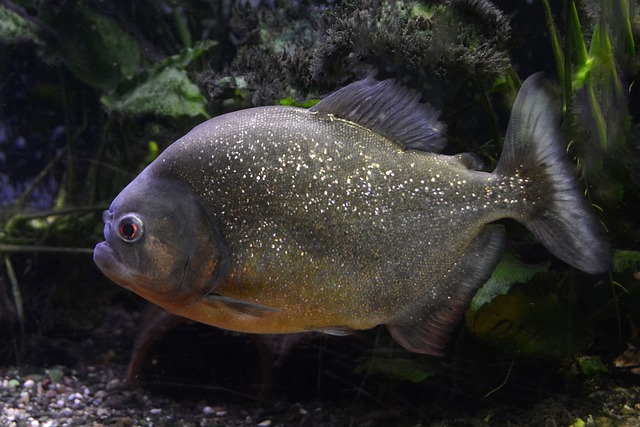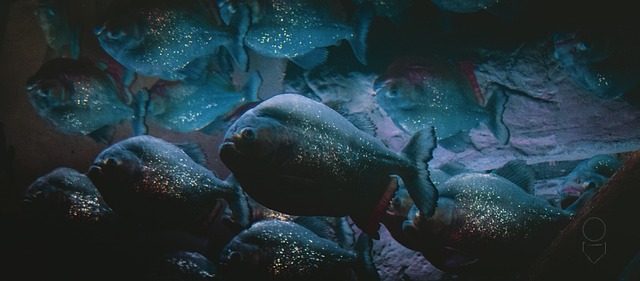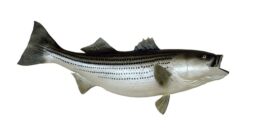Piranha and pacu fish are both freshwater fish, but there is a big difference between them. Piranha fish are notorious for their razor-sharp teeth and ability to inflict serious injury on humans, while pacu fish are less aggressive and much harder to catch.
Piranha
(Image by annca from Pixabay )

Piranha fish is a common name for several species of freshwater fish that are native to South America. They are known for their sharp teeth and aggressive behavior, which makes them a popular topic in popular culture. In reality, piranhas are omnivores and do not pose a significant threat to humans unless they are provoked. Piranhas are also important to the ecosystem as they play a role in maintaining the balance of the food chain by consuming dead or injured animals. Piranhas are popular in the aquarium trade and are kept as pets by fish enthusiasts.
Pacu
(Image by Светлана from Pixabay )

Pacu fish is a species of freshwater fish native to South America, similar in appearance to the piranha fish. Unlike piranhas, however, pacus are omnivorous and feed primarily on nuts, fruits, and other plant material. They are also less aggressive than piranhas and are generally considered peaceful fish. Pacus are popular in the aquarium trade due to their large size and attractive appearance. They can grow up to 3 feet in length and weigh up to 30 pounds. Pacus are also commonly farmed for food and are considered a delicacy in some parts of the world.
Differences in Diet
Despite their physical similarities, there are a few major dietary differences between piranha and pacu fish. Piranha typically eat meat, including other fish, while pacu generally prefer vegetation. Additionally, piranha have a higher level of mercury in their blood than pacu fish do. This is due to the fact that piranhas are predators that feed largely on larger animals that have high levels of mercury in their tissues.
Behavior
Piranhas and pacu fish are both freshwater species found in South America, but they exhibit different behaviors. Piranhas are primarily carnivorous and feed on small fish and other animals, and their aggressive behavior is a result of this diet. They have sharp teeth that allow them to quickly tear apart their prey, and they are known to attack other fish and even humans if they are provoked. Piranhas have a reputation for being dangerous and aggressive, but this behavior is usually exaggerated in popular culture.
Pacu fish, on the other hand, are omnivorous and feed primarily on nuts, fruits, and other plant material. They are less aggressive than piranhas and are generally considered peaceful. Pacus are not known to attack other fish or humans, and they are less likely to cause harm in an aquarium setting. Instead, they are known for their large size and attractive appearance, and they are popular in the aquarium trade.
Both piranhas and pacus play important roles in the ecosystem, with piranhas serving as top predators that help maintain the balance of the food chain, and pacus serving as herbivores that feed on plant material and help control the growth of aquatic vegetation.
while both piranhas and pacus are freshwater species found in South America, they exhibit different behaviors and play distinct roles in their respective ecosystems.
Do pacu fish and piranhas look the same?
No, pacu fish and piranhas do not look the same. While they are both freshwater species found in South America and have a similar shape, they have distinct physical characteristics that set them apart.
Pacu fish are larger and have a more rounded body, with a broader head and smaller, flatter teeth. They also have a more distinct chin, which sets them apart from piranhas. Pacus are often brightly colored and can range from silver to brown to black, with red or orange fins.
Piranhas, on the other hand, have a more slender body and a sharper, more pointed snout. They have larger, razor-sharp teeth that are designed for tearing and crushing, and they are known for their aggressive behavior. Piranhas are often brightly colored and can range from red to yellow to black, with white or silver accents.
Though pacu fish and piranhas may look similar in shape, they have distinct physical characteristics that set them apart.
Is Red pacu a piranha?
Red pacu is not a piranha. Piranhas are found in South America and have three sharp teeth in the front of their mouth that they use to slice through meat. Pacus have two pairs of teeth in the front of their mouths, but also have some in the back. They are mostly found in the Amazon River basin and can grow up to two feet long.
Are pacu fish aggressive?
Pacu fish are not aggressive by nature, but they can become aggressive if they feel threatened. Piranha fish, on the other hand, are known for their aggression. Pacu fish typically grow to a length of 12 inches, while piranha fish typically grow to a length of up to 6 feet.
Do piranhas hurt you?
Piranhas are capable of biting humans, but attacks are rare and typically occur only if the fish feel threatened or provoked. In general, piranhas are not considered a significant threat to humans, and most incidents involving piranhas are minor and result in only minor injuries. However, it is important to exercise caution and respect the fish’s natural behavior, as they are wild animals and can bite if they feel threatened. If you plan to swim in a body of water known to contain piranhas, it is recommended that you take necessary precautions to avoid attracting the fish and take steps to protect yourself from any potential bites.
How dangerous are piranhas?
Piranhas and pacu fish are two types of fish that can be found in the Amazon River. They are both considered to be dangerous, although there is some debate as to which is more dangerous. Pacu fish are generally considered to be less dangerous, although piranhas have been known to attack humans. Piranhas typically eat fish, but they have been known to attack and eat other animals, including people. Pacu fish are not as common as piranhas in the wild, but they can also be aggressive when mating or defending their territory.
What to do if attacked by piranhas?
If you are caught up in the middle of an attack by piranhas, the best thing to do is to stay calm and swim towards a rock or other sturdy object. Piranha fish typically attack prey that is smaller or weaker than themselves, so if you are larger and stronger, they may not bother you. If they start to attach themselves to you, use your hands and feet to fight them off. Never try to strike at them with anything sharp – their razor-sharp teeth can easily slice through skin. Finally, if possible, make a loud noise and attract the attention of nearby wildlife so they can help you escape.
What eats a piranha?
Piranhas are at the top of the food chain in their natural habitats and have few natural predators. However, some species of birds, such as the heron and cormorant, will eat smaller piranhas. Larger piranhas are also sometimes preyed upon by dolphins, caimans, and other species of fish. In addition, young piranhas can fall prey to larger piranhas, as they are often cannibalistic. In some instances, humans also hunt piranhas for food and sport. Overall, piranhas have few natural predators and play an important role in maintaining the balance of the food chain in their habitats.
What is the rarest piranha?
The rarest piranha species is considered to be the Santa Cruz Lima, also known as the red-bellied piranha or Pygocentrus nattereri. This species is native to the Guapore and Madeira river basins in South America and is considered to be one of the most abundant and widely distributed species of piranha. However, populations of the Santa Cruz Lima have declined in recent years due to habitat loss and overfishing, and it is now considered to be rare in some areas. In addition to the Santa Cruz Lima, there are several other species of piranhas that are considered to be threatened or endangered due to habitat loss, overfishing, and other human-related activities.
Whare are piranhas and pacu fish found?
Piranhas and pacu are primarily found in South America, in the freshwater rivers and tributaries of the Amazon Basin. Some species of piranhas and pacus can also be found in other parts of South America, including the Orinoco River Basin in Venezuela and the Paraná River Basin in Brazil, Argentina, and Paraguay.
How big do pacu piranhas get?
The biggest pacu fish can grow up to two feet long and weigh more than thirty pounds. Piranhas, on the other hand, are generally much smaller, typically growing to around a foot in length and weighing around three pounds. Pacu are also known for their ferocious piranha-like attacks, while piranhas are considered poor fighters and scavengers.
What are the types of piranha?
There are many different types of piranha, but they all share some common features. Piranhas typically have a long body with a sharp, pointed head. They also have large eyes and teeth that are adapted for eating meat. Some piranhas have further evolved to attack other fish in their environment, which makes them dangerous predators.
There are about 60 species of piranha, and they belong to the genus Pygocentrus and Serrasalmus. Some of the most well-known species include
- Red-Bellied Piranha (Pygocentrus nattereri) – It is a large species of piranha with a distinctive red belly and sharp teeth. They are native to South America.
- Black Piranha (Serrasalmus rhombeus) – It is a small but aggressive species of piranha with a distinctive black coloration. They are native to the Amazon Basin.
- Pacu (Colossoma macropomum) – It is a species of piranha that is primarily herbivorous and is often kept as an aquarium fish. They are native to South America.
- Pristobrycon calmoni – It is a species of piranha that is native to South America and is known for its long, slender body and sharp teeth.
- Serrasalmus elongatus – It is a species of piranha that is native to South America and is known for its elongated body and aggressive behavior. They have a narrow, pointed snout and large, sharp teeth.
What are the types of paccu fish?
- Tambaqui (Colossoma macropomum) – It is a large species of pacu that is native to South America and is often kept as a food fish in aquaculture. They are omnivorous and feed on a variety of plants and animals.
- Silver Pacu (Piaractus brachypomus) – It is a species of pacu that is native to South America and is known for its silvery coloration. They are primarily herbivorous and feed on aquatic plants.
- Red Bellied Pacu (Piaractus gulosus) – It is a species of pacu that is native to South America and is known for its distinctive red belly and large size. They are primarily herbivorous and feed on aquatic plants.
- Black Pacu (Mylossoma duriventre) – It is a species of pacu that is native to South America and is known for its black coloration. They are omnivorous and feed on a variety of plants and animals.
- Speckled Pacu (Metynnis maculatus) – It is a species of pacu that is native to South America and is known for its speckled coloration. They are omnivorous and feed on a variety of plants and animals.
What are the requirements to keep piranhas as pets?
To keep piranhas as pets, the following requirements should be met:
- Aquarium size – Piranhas require a large aquarium as they can grow up to 30 cm or more. A minimum tank size of 200-300 gallons is recommended for a single piranha.
- Water temperature – Piranhas prefer warm water, with a temperature between 25-30°C. A heater and thermometer are required to maintain the water temperature.
- Water quality – Piranhas are sensitive to water quality, and regular water changes and filtration are necessary to keep the water clean and healthy.
- Diet – Piranhas are carnivorous and require a diet of live or frozen fish, shrimp, worms, and other meaty foods. They should be fed twice a day in small amounts.
- Tank mates – Piranhas are aggressive and should not be kept with other fish. If kept with other piranhas, it is important to have enough space for each fish to establish its own territory.
- Lighting – Piranhas do not require special lighting, but it is important to provide adequate lighting to maintain a healthy and natural environment.
- Monitoring – Regular monitoring of the water parameters, diet, and behavior of the piranhas is important to ensure they are healthy and thriving.
What are the requirements to keep pacu fish as pets?
To keep pacu fish as pets, the following requirements should be met:
- Aquarium size – Pacu are large fish and require a spacious aquarium, with a minimum tank size of 200 gallons for a single fish.
- Water temperature – Pacu prefer warm water, with a temperature between 25-30°C. A heater and thermometer are required to maintain the water temperature.
- Water quality – Pacu are sensitive to water quality, and regular water changes and filtration are necessary to keep the water clean and healthy.
- Diet – Pacu are omnivorous and require a varied diet of both plant and animal matter. They should be fed a diet of pellets, vegetables, fruit, and occasional live or frozen foods.
- Tank mates – Pacu can be kept with other large, peaceful fish, but it is important to have enough space for each fish to establish its own territory.
- Lighting – Pacu do not require special lighting, but it is important to provide adequate lighting to maintain a healthy and natural environment.
- Monitoring – Regular monitoring of the water parameters, diet, and behavior of the pacu is important to ensure they are healthy and thriving.









